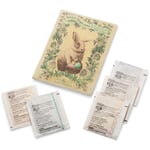Natural egg colors

Natural egg colors
- Pure natural colors: curcumin, carmine and chlorophyllin
- Intense: produces rich red, yellow, green, orange and pink
- Extremely easy to use: Stir colors into the cooking water
General Information
An Easter egg must be colorful ...
... this is practically a law of nature (by tradition). Colorful and healthy, we might add, and dye our eggs with pure natural dyes. To avoid having to prepare onions, red cabbage and spinach for dyeing, we use these natural egg dyes. They contain the natural dyes curcumin, carmine and chlorophyllin - and these dyes are all you need to dye your eggs a comparatively bright yet rich red, yellow, green, orange or pink. And since no two eggs are the same - rough or smooth shells, different shades of brown, speckles and so on - the dyed eggs will also take on slightly varying shades of color. Don't be put off: some colors increase in intensity as they cool.
If you find that the single-colored Easter egg doesn't offer enough variety in the long run, simply get your family and friends to join in the fun of dyeing and decorating eggs: Dip a cotton bud briefly in a little lemon juice or vinegar and you can decorate your Easter eggs with the most beautiful patterns.
The Egg and the Easter Celebrations.
Which came first: the rabbit or the egg? At Easter, we can make an unqualified case for the egg: Since the earliest beginnings of Christianity, the egg has been a symbol of fertility; it stands for new life and the resurrection of Christ. The Easter bunny, by contrast, had to prevail against illustrious competitors before it could establish itself as the exclusive egg supplier, depending on the region: the fox, the cuckoo and the stork – or even against the church bells flying home from Rome. Of course, not only the egg itself but also its colouring has a special significance. In the sphere of influence of the Orthodox Church, you found traditionally eggs dyed exclusively in red – in Christian symbolism, red stands for the blood of Christ. Over time and regionally differentiated, especially the Roman Catholic Church added other colours and significant meanings, for example, white symbolizing purity, yellow representing wisdom, and orange signifying endurance and strength.
Besides the festive-decorative purpose, there once was a thoroughly functional purpose that led to the dyeing of eggs (and, at the same time, to the tradition of hard-boiled Easter eggs): The peasants of the Middle Ages dyed their own eggs red to distinguish them from those they had to hand over to their landlord. What’s more, farmers preserved eggs by boiling them during the forty-day fasting period, when it was not allowed to eat eggs. Dyeing the different batches of eggs in one colour each helped colour-coding them before storing. The coding gave the farmers an overview of the growing supply of eggs and was an early form of best-before date. One could easily tell which batch of eggs comprised the oldest and was first in line for consumption.
Ingredients:
Colorants: curcumin, carmine, chlorophyllin. Other ingredient: Rock salt
Product Information
Article Number 212750
- Pure natural colors: curcumin, carmine and chlorophyllin
- Intense: produces rich red, yellow, green, orange and pink
- Extremely easy to use: Stir colors into the cooking water
Set of 5 different egg colors (red, yellow, green, orange, pink).
Have a question?
If you have a question concerning this product you are welcome to contact us. For this your E-Mail program will open.
Customer Service
Whether its advice, spare parts, or special requests - all your questions and concerns are handled personally and thoroughly by our customer service.
You can contact us anytime at info@manufactum.dk

